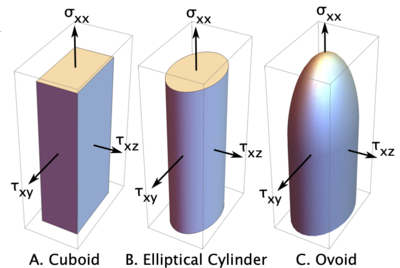Difference between revisions of "Isotropic Material Failure Surface"
| Line 40: | Line 40: | ||
| tauc ||Critical shear stress for failure || [[ConsistentUnits Command#Legacy and Consistent Units|pressure units]] || infinite | | tauc ||Critical shear stress for failure || [[ConsistentUnits Command#Legacy and Consistent Units|pressure units]] || infinite | ||
|- | |- | ||
| PressureModel | Pick a model (0 to 4) to model [[#Presure Dependent Shear Strength|pressure dependent shear strength]] || none || 0 | | PressureModel || Pick a model (0 to 4) to model [[#Presure Dependent Shear Strength|pressure dependent shear strength]] || none || 0 | ||
|- | |- | ||
| tauh || Hydrostatic tension that causes shear strength to drop to zero for pressure model 1 || [[ConsistentUnits Command#Legacy and Consistent Units|pressure units]] || infinite | | tauh || Hydrostatic tension that causes shear strength to drop to zero for pressure model 1 || [[ConsistentUnits Command#Legacy and Consistent Units|pressure units]] || infinite | ||
Revision as of 14:50, 31 January 2023
Introduction
This damage initiation law predicts that failure initiates when maximum principal stress exceeds tensile strength of the material or when maximum shear stress exceeds shear strength of the material. It can also model pressure-dependent initiation stresses. Because it deals with principal stresses and tensile failure is the same regardless of direction, this law is only appropriate for isotropic materials such as an IsoSoftening material.
Failure Surface
Three possible failure stress failure surfaces are shown in the figure. The surface along each axis gives the current strength by that stress. The current strength may depended on external variables such as pressure, strain rate in more. During damage evolution, the current strength will also depend on current damage state. Which failure surface to use for initiation and subseqent damage evolution is determined by the tractionFailureSurface property of the parent isotropic softening material. The calculations for current strength transpose these surfaces to principle stress space and find critical stress by Mohr's circle calculations. The details are given in Ref. [1].
Pressure Dependent Shear Strength
Although generalized damage mechanics[1] provides a method to allow the failure surface to depend on any external variable, the only external dependence currently modeled is to allow shear strength to depend on pressure.
Model 0: shear strength is independent of pressure
Model 1: shear strength is linear in pressure:
[math]\displaystyle{ \tau = \tau_c\left(1 + {P\over \tau_h}\right) }[/math]
where [math]\displaystyle{ \tau_h }[/math] is hydrostatic tension that causess shear strength to reach zero under hydrostatic tension when [math]\displaystyle{ P=-\tau_h }[/math]. Note with out pressure dependence, a material never failures by shear strength in hydrostatic stress states. Furthermore, [math]\displaystyle{ \tau_h }[/math] must be higher the normal strength [math]\displaystyle{ \sigma_c }[/math].
Model 2: shear strength is step linear. The shear strength below [math]\displaystyle{ P_1 }[/math] is equal to basic shear strength, [math]\displaystyle{ \tau_c }[/math], but for [math]\displaystyle{ P\gt P_1 }[/math], it increases linearly to [math]\displaystyle{ \tau_{max} }[/math] at [math]\displaystyle{ P_1 }[/math]. Above [math]\displaystyle{ P_1 }[/math], the shear strength is constant. For [math]\displaystyle{ P\gt P_1 }[/math], the shear strength is
[math]\displaystyle{ \tau = \tau_c + {\tau_{max}-\tau_c \over P_2-P_1}\bigl(\min(P,P_2)-P_1\bigr) }[/math]
Damage Law Properties
The following table lists the input properties for maximum principal stress failure surface:
| Property | Description | Units | Default |
|---|---|---|---|
| sigmac | Critical tensile stress for failure | pressure units | infinite |
| tauc | Critical shear stress for failure | pressure units | infinite |
| PressureModel | Pick a model (0 to 4) to model pressure dependent shear strength | none | 0 |
| tauh | Hydrostatic tension that causes shear strength to drop to zero for pressure model 1 | pressure units | infinite |
